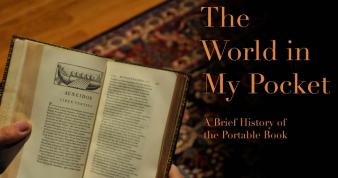The World in My Pocket

A Brief History of the Portable Book
In Hereford Cathedral in England, there is an old and venerable library of books, most of which are in stout folio formats. The earliest of these dates back to the eighth century. Each book may still be examined and read, but because they are all chained to their shelves, no volume can travel any further from its shelf than the length of its chain! This once common library security system now seems quaint and slightly ridiculous, but it illustrates two points about many of the works created during the early centuries of bookmaking: 1. Books were too valuable and scarce to circulate freely. 2. Books tended to be large and not particularly portable objects. Exactly when the first small and reasonably economical books were made available to readers would be all but impossible to determine. Perhaps it happened twenty-five hundred years before the birth of Christ, when a handy, palm-sized cuneiform tablet was molded by a Sumerian scribe and casually stuffed into a pocket. Did the idea reappear centuries later when a miniature scroll accompanied an Egyptian merchant on his travels? Or again when a small quire of folded vellum sheets was packed away into the kit of a Roman legionnaire? Surely the impulse to create an intimate, anytime, anywhere reading experience has been around as long as the book itself. And for all the joys of assembling a library of fine, nobly proportioned books (and providing for the modern equivalent of a chain security system), it is the lowly pocket book that may give us the most pleasure. It entails no expectations on us beyond the lure of the turned-down corner of some page inside, urging us to pick up wherever we left off – at the beach, on the subway, or at home after a day’s work. This exhibition is not an attempt to provide a scholarly history of the pocket book. That would take far more space and call for some serious scholarship! Rather, it presents the results of a meandering and thoroughly delightful journey through the shelves of the Cary Collection, where many small books nestle up against their larger neighbors, waiting patiently to be noticed. The arrangement is largely chronological; it starts it in the first case at the left with a leaf from a medieval manuscript and concludes in the cases on the far right with two intriguing attempts to win the hearts of twenty-first-century readers. The first is an arrangement of paperback titles from a publication program recently launched by Penguin called the Great Ideas Series. The other is an e-reader, namely the Barnes & Noble Nook Touch, the latest entry in the effort to win readers over to the world of digital publishing. The printed book endures, but will an e-reader, in the end, represent the first realistic hope of carrying the world in one’s pocket? —David Pankow, Curator





